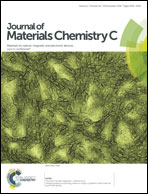A silicon-cored fluoranthene derivative as a fluorescent probe for detecting nitroaromatic compounds
Abstract
Two fluoranthene derivatives, nonsilicon-cored 7,10-diphenylfluoranthene (DF) and silicon-cored bis(7,10-diphenylfluoranthen-8-yl)diphenylsilane (BDS), were synthesized via the Knoevenagel/Diels–Alder method. The thermal properties and fluorescence quenching behavior of the derivatives with nitroaromatic compounds were investigated. Aside from its better thermal properties, BDS also showed lower detection limit, higher sensitivity, and higher quenching efficiency in detecting nitrobenzene and m-dinitrobenzene than DF. The detection limits of BDS were 50 and 10 ppm toward nitrobenzene and m-dinitrobenzene, respectively. Moreover, the Stern–Volmer plot of BDS swiftly curved upward, suggesting a super amplification effect. This result can be attributed to the special tetrahedral structure of BDS. Thus, BDS has great potential in the detection of explosives. This work may serve as a basis for designing new organic materials with great efficiency and sensitivity in fluorescence detection.


 Please wait while we load your content...
Please wait while we load your content...